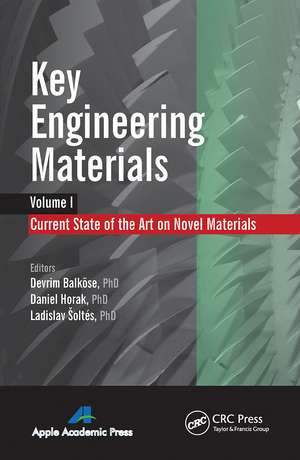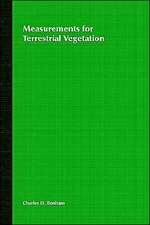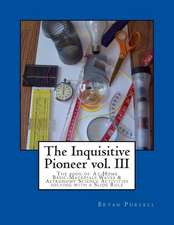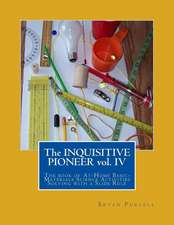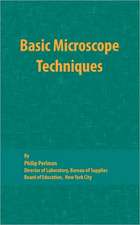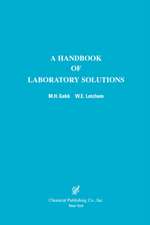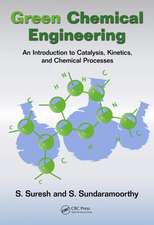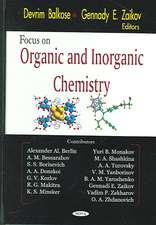Key Engineering Materials, Volume 1: Current State-of-the-Art on Novel Materials
Editat de Devrim Balköse, Daniel Horak, Ladislav Šoltésen Limba Engleză Paperback – 31 mar 2021
The book follows a more quantitative and design-oriented approach than other texts in the market, helping readers gain a better understanding of important concepts. They’ll also discover how material properties relate to the process variables in a given process as well as how to perform quantitative engineering analysis of manufacturing processes.
| Toate formatele și edițiile | Preț | Express |
|---|---|---|
| Paperback (1) | 579.62 lei 6-8 săpt. | |
| Apple Academic Press Inc. – 31 mar 2021 | 579.62 lei 6-8 săpt. | |
| Hardback (1) | 1124.16 lei 6-8 săpt. | |
| Apple Academic Press Inc. – 14 feb 2014 | 1124.16 lei 6-8 săpt. |
Preț: 579.62 lei
Preț vechi: 681.91 lei
-15% Nou
Puncte Express: 869
Preț estimativ în valută:
110.93€ • 115.38$ • 91.57£
110.93€ • 115.38$ • 91.57£
Carte tipărită la comandă
Livrare economică 14-28 aprilie
Preluare comenzi: 021 569.72.76
Specificații
ISBN-13: 9781774633007
ISBN-10: 1774633000
Pagini: 584
Ilustrații: 238
Dimensiuni: 152 x 229 x 30 mm
Greutate: 0.45 kg
Ediția:1
Editura: Apple Academic Press Inc.
Colecția Apple Academic Press
ISBN-10: 1774633000
Pagini: 584
Ilustrații: 238
Dimensiuni: 152 x 229 x 30 mm
Greutate: 0.45 kg
Ediția:1
Editura: Apple Academic Press Inc.
Colecția Apple Academic Press
Public țintă
Academic and PostgraduateCuprins
Preparation and Properties of Animal Protein Hydrolysates for Optimal Adhesive Compositions. Collagen Modified Hardener for Melamine-Formaldehyde Adhesive for Increasing Water-Resistance of Plywood. Possibilities of Application of Collagen Coloid from Secondary Raw Materials as Modifier of Polycondensation Adhesives. Reuse of Industrial Wastes as Construction Key Material. A New Generation of Composite Solid Propellants. Key Elements on Surface Properties of Polyimide Copolymers. A CFD Model for Polymer Fuel Cell. Polyhydroxybutyrate–Chitosan Mixed Compositions Under External Influences Changes In the Structural Parameters and Molecular Dynamics. Key Concepts on Transforming Magnetic Photocatalyst to Magnetic Dye-Adsorbent Catalyst. New Types of Ethylene Copolymers on the Base Nanocomposite. Hyperbranched Polymers: A Promising New Class of Key Engineering Materials. Current Status and Biomedical Application Spectrum of Poly(3- Hydroxybutyrate as a Bacterial Biodegradable Polymer. Key Concepts on Growth and Characterization of Metal Nano-Sized Branched Structures. Preparation, Characterization and Applications of Magnesium Stearate, Cobalt Stearate and Copper Stearate. Control of the Particle Size and Purity of Nano Zinc Oxide. Water Sorption of Polyvinyl Chloride–Luffa Cylindrica Composites. Key Engineering Properties of Nanofiller Particles. Nanoparticles In Polymeric Nanocomposites. Biodegradation Mechanism of Some Polymers. The Sources of Biodamages. Elastomeric Nanocomposites. Aggregation Model. Nanofiller In Elastomeric Matrix. Structure and Properties. Hydrodynamics of Gas-Liquid-Solid Fluidized Bed Reactor. Rubber Technology Compounding and Testing for Performance. The Butyl Rubber Compounds. Adhesive Properties. Rubber Technology Compounding and Testing for Performance. Сomposites on the Base of Polypropylene and Ethylene-Octene Rubber. Antifungal Activity of Aminated Chitosan Against Three Different Fungi Species. Biodegradable Binary and Ternary Blends. Structure and Relaxation Properties of Elastomers. A Study on Carbon Nanotubes Structure In Polymer Nanocomposites. Key Elements on Synthesis, Structure, Physicochemical Properties and Application of Polyacetylene. Progress in Pore Structure Analysis of Porous Membranes. Index.
Notă biografică
Devrim Balköse, PhD, graduated from Middle East Technical University (Ankara, Turkey) Chemical Engineering Department in 1969. She received her MS and PhD degrees from Ege University, İzmir, Turkey, in 1974 and 1977 respectively. She became Associate Professor in macromolecular chemistry in 1983 and Professor in process and reactor engineering in 1990. She worked as research assistant, assistant professor, associate professor, and professor between 1970-2000 at Ege University. She was the Head of Chemical Engineering Department at İzmir Institute of Technology, İzmir, Turkey, between 2000-2009. She is now a faculty member in the same department. Her research interests are in polymer reaction engineering, polymer foams and films, adsorbent development, and moisture sorption. Her research projects are on nanosized zinc borate production, ZnO polymer composites, zinc borate lubricants, antistatic additives, and metal soaps.
Daniel Horak, PhD, graduated from the Institute of Chemical Technology in Prague, Czech Republic, where he received MSc degree in macromolecular chemistry. His PhD degree in chemistry was obtained from the Institute of Macromolecular Chemistry, Academy of Sciences of the Czech Republic , where he is employed as the Head of the Department of Polymer Particles. He was a post-doctoral fellow at the University of Ottawa in Canada with Professor Frechet in 1983-84, winner of the scholarship from the Japanese Society for Promotion of Science, at the Technological University of Nagaoka with Professor Imai in Japan in 1987-88, visiting scientist at the Cornell University in Ithaca, New York, with Professor Frechet in 1993-94. He also served as a visiting scientist at the University of Montreal in Canada in 2001. His research activity includes magnetic nano- and microspheres, polymer particles by heterogeneous polymerization techniques including emulsion, suspension, and dispersion polymerization; properties of the particles, their chemical modifications and applications in medicine, biochemistry, and biotechnology; immobilization of enzymes and antibodies; hydrogels, sorbents and ion exchangers; and advanced separation media. He is member of the International Polymer Colloid Group, organizer and chairman of the Polymer Colloid Symposium in Prague 2008 and 2014, editorial board member of Journal of Colloid Science and Biotechnology, and supervisor of PhD students. He has published more than 150 original scientific papers, 7 book chapters (Polymeric Materials Encyclopedia, Strategies in Size Exclusion Chromatography, Citus Books), 10 reviews, many lectures and communications at international symposia, and 7 patents. He has published in Biomaterials, Bioconjugate Chemistry, Journal of Polymer Science, Polymer Chemistry Edition, Polymer, Journal of Materials Chemistry, Chemistry of Materials, among others.
Ladislav Šoltés, PhD, was born in 1950 in Czechoslovakia. His expertise encompasses macromolecular and analytical chemistry. He has been employed for over 30 years at academic research institutes in Bratislava , Slovakia. His research related to the polysaccharides, which started over two decades ago, resulted in patenting a novel approach "clathrate complexes formed by hyaluronic acid derivatives and use thereof as pharmaceuticals". His current research interests are focused on the studies of hyaluronan oxidative damage and the regulation of this process. Dr. Šoltés is the only distinguished representative of Slovakia in the International Society for Hyaluronan Sciences, USA. In 2007 he was named Scientist of the Year of the Slovak Republic.
Daniel Horak, PhD, graduated from the Institute of Chemical Technology in Prague, Czech Republic, where he received MSc degree in macromolecular chemistry. His PhD degree in chemistry was obtained from the Institute of Macromolecular Chemistry, Academy of Sciences of the Czech Republic , where he is employed as the Head of the Department of Polymer Particles. He was a post-doctoral fellow at the University of Ottawa in Canada with Professor Frechet in 1983-84, winner of the scholarship from the Japanese Society for Promotion of Science, at the Technological University of Nagaoka with Professor Imai in Japan in 1987-88, visiting scientist at the Cornell University in Ithaca, New York, with Professor Frechet in 1993-94. He also served as a visiting scientist at the University of Montreal in Canada in 2001. His research activity includes magnetic nano- and microspheres, polymer particles by heterogeneous polymerization techniques including emulsion, suspension, and dispersion polymerization; properties of the particles, their chemical modifications and applications in medicine, biochemistry, and biotechnology; immobilization of enzymes and antibodies; hydrogels, sorbents and ion exchangers; and advanced separation media. He is member of the International Polymer Colloid Group, organizer and chairman of the Polymer Colloid Symposium in Prague 2008 and 2014, editorial board member of Journal of Colloid Science and Biotechnology, and supervisor of PhD students. He has published more than 150 original scientific papers, 7 book chapters (Polymeric Materials Encyclopedia, Strategies in Size Exclusion Chromatography, Citus Books), 10 reviews, many lectures and communications at international symposia, and 7 patents. He has published in Biomaterials, Bioconjugate Chemistry, Journal of Polymer Science, Polymer Chemistry Edition, Polymer, Journal of Materials Chemistry, Chemistry of Materials, among others.
Ladislav Šoltés, PhD, was born in 1950 in Czechoslovakia. His expertise encompasses macromolecular and analytical chemistry. He has been employed for over 30 years at academic research institutes in Bratislava , Slovakia. His research related to the polysaccharides, which started over two decades ago, resulted in patenting a novel approach "clathrate complexes formed by hyaluronic acid derivatives and use thereof as pharmaceuticals". His current research interests are focused on the studies of hyaluronan oxidative damage and the regulation of this process. Dr. Šoltés is the only distinguished representative of Slovakia in the International Society for Hyaluronan Sciences, USA. In 2007 he was named Scientist of the Year of the Slovak Republic.
Descriere
With coverage of a broad range of key engineering materials, this book provides a single, comprehensive book summarizing all aspects involved in the functional materials production chain. It introduces state-of-the-art technology in key engineering materials, emphasizing the rapidly growing technologies. It takes a unique approach by presenting
